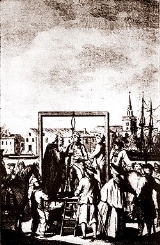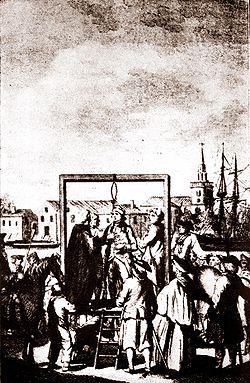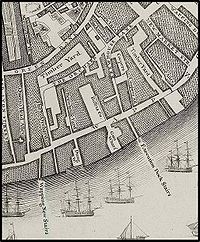
Execution Dock
Encyclopedia

London
London is the capital city of :England and the :United Kingdom, the largest metropolitan area in the United Kingdom, and the largest urban zone in the European Union by most measures. Located on the River Thames, London has been a major settlement for two millennia, its history going back to its...
to execute pirates, smugglers and mutineer
Mutiny
Mutiny is a conspiracy among members of a group of similarly situated individuals to openly oppose, change or overthrow an authority to which they are subject...
s that had been sentenced to death by Admiralty court
Admiralty court
Admiralty courts, also known as maritime courts, are courts exercising jurisdiction over all maritime contracts, torts, injuries and offences.- Admiralty Courts in England and Wales :...
s. The "dock", which consisted of a scaffold
Gallows
A gallows is a frame, typically wooden, used for execution by hanging, or by means to torture before execution, as was used when being hanged, drawn and quartered...
for hanging
Hanging
Hanging is the lethal suspension of a person by a ligature. The Oxford English Dictionary states that hanging in this sense is "specifically to put to death by suspension by the neck", though it formerly also referred to crucifixion and death by impalement in which the body would remain...
, was located near the shoreline of the River Thames
River Thames
The River Thames flows through southern England. It is the longest river entirely in England and the second longest in the United Kingdom. While it is best known because its lower reaches flow through central London, the river flows alongside several other towns and cities, including Oxford,...
at Wapping
Wapping
Wapping is a place in the London Borough of Tower Hamlets which forms part of the Docklands to the east of the City of London. It is situated between the north bank of the River Thames and the ancient thoroughfare simply called The Highway...
. Its last executions were in 1830.
History
The legal jurisdiction for the British AdmiraltyAdmiralty
The Admiralty was formerly the authority in the Kingdom of England, and later in the United Kingdom, responsible for the command of the Royal Navy...
was for all crimes committed at sea. The dock symbolised that jurisdiction by being located just beyond the low-tide mark in the river. Anybody who had committed crimes on the seas, either in home waters or abroad, would eventually be brought back to London and tried by the High Court of the Admiralty .
Capital punishment was reserved for acts of mutiny that resulted in death and for murders on the High Seas. Those sentenced to death were usually brought to Execution Dock from Marshalsea Prison (although some were also transported from the Newgate
Newgate Prison
Newgate Prison was a prison in London, at the corner of Newgate Street and Old Bailey just inside the City of London. It was originally located at the site of a gate in the Roman London Wall. The gate/prison was rebuilt in the 12th century, and demolished in 1777...
). The condemned were paraded across London Bridge
London Bridge
London Bridge is a bridge over the River Thames, connecting the City of London and Southwark, in central London. Situated between Cannon Street Railway Bridge and Tower Bridge, it forms the western end of the Pool of London...
past the Tower of London
Tower of London
Her Majesty's Royal Palace and Fortress, more commonly known as the Tower of London, is a historic castle on the north bank of the River Thames in central London, England. It lies within the London Borough of Tower Hamlets, separated from the eastern edge of the City of London by the open space...
. The procession was led by the High Court Marshal on horseback (or his deputy). He carried a silver oar that represented the authority of the Admiralty. Prisoners were transported in a cart to Wapping, with them was a chaplain
Chaplain
Traditionally, a chaplain is a minister in a specialized setting such as a priest, pastor, rabbi, or imam or lay representative of a religion attached to a secular institution such as a hospital, prison, military unit, police department, university, or private chapel...
who encouraged them to confess their sins. Just like the execution procession to Tyburn
Tyburn
Tyburn is a former village just outside the then boundaries of London that was best known as a place of public execution.Tyburn may also refer to:* Tyburn , river and historical water source in London...
, condemned prisoners were allowed to drink a quart of ale at a public house on the way to the gallows. An execution at the dock usually meant that crowds lined the river's banks or chartered boats moored in the Thames to get a better view of the hangings. Executions were conducted by the hangmen who worked at either Tyburn and Newgate Prison.
With a particular cruelty reserved for those convicted of acts of piracy, hanging was done with a shortened rope. This meant a slow death from strangulation on the scaffold as the drop was insufficient to break the prisoner's neck. It was called the Marshal's dance because their limbs would often be seen to 'dance' from slow asphyxiation. Unlike hangings on land such as at Tyburn
Tyburn, London
Tyburn was a village in the county of Middlesex close to the current location of Marble Arch in present-day London. It took its name from the Tyburn or Teo Bourne 'boundary stream', a tributary of the River Thames which is now completely covered over between its source and its outfall into the...
, the bodies of pirates at Execution Dock were not immediately cut down following death. Customarily, these corpses were left hanging on the nooses until at least three tides had washed over their heads. This practice stopped at the end of the 18th century. In the cases of the most notorious offenders, the Admiralty would order that their bodies were to be tarred and hung in chains
Gibbet
A gibbet is a gallows-type structure from which the dead bodies of executed criminals were hung on public display to deter other existing or potential criminals. In earlier times, up to the late 17th century, live gibbeting also took place, in which the criminal was placed alive in a metal cage...
at either Cuckold's Point
Cuckold's Point
Cuckold's Point is the name given to part of a sharp bend on the River Thames on the Rotherhithe peninsula, south-east London, opposite the West India Docks...
or Blackwall Point
Greenwich Peninsula
Greenwich Peninsula is an area of South London, England, located in the London Borough of Greenwich.The peninsula is bounded on three sides by a loop of the Thames, between the Isle of Dogs and Silvertown. To the south is the rest of Greenwich, to the south-east is Charlton.The peninsula lies...
- on the River Thames - as a warning to all seafarers about the fate awaiting those who turned to piracy.
An account from The Gentleman's Magazine, dated February 4, 1796, gives a vivid portrayal of a typical execution at London's Execution Dock.
"This morning, a little after ten o'clock, Colley, Cole, and Blanche, the
three sailors convicted of the murder of Captain Little, were brought out of Newgate,
and conveyed in solemn procession to Execution Dock, there to receive the punishment
awarded by law. On the cart on which they rode was an elevated stage; on this were
seated Colley, the principal instigator in the murder, in the middle, and his two
wretched instruments, the Spaniard Blanche, and the Mulatto Cole, on each side of him;
and behind, on another seat, two executioners.
Colley seemed in a state resembling that of a man stupidly intoxicated, and scarcely
awake, and the two discovered little sensibility on this occasion, nor to the last
moment of their existence, did they, as we hear, make any confession. They were turned
off about a quarter before twelve in the midst of an immense crowd of spectators.
On the way to the place of execution, they were preceded by the Marshall of the Admiralty
in his carriage, the Deputy Marshall, bearing the silver oar, and the two City Marshals
on horseback, Sheriff's officers, etc. The whole cavalcade was conducted with great
solemnity."
The infamous Captain Kidd, who had been convicted of piracy and murder, was taken from Newgate Prison
Newgate Prison
Newgate Prison was a prison in London, at the corner of Newgate Street and Old Bailey just inside the City of London. It was originally located at the site of a gate in the Roman London Wall. The gate/prison was rebuilt in the 12th century, and demolished in 1777...
and executed at the dock in 1701. During his execution, the rope broke and Kidd was hanged on the second attempt. His remains were gibbeted by the river Thames at Tilbury for more than twenty years.
Sailors George Davis and William Watts, who were convicted of murdering a ship's captain, were the final hangings at the dock on December 16, 1830.
Location


